DISCUSSION OF AGROCYBE ACERICOLA
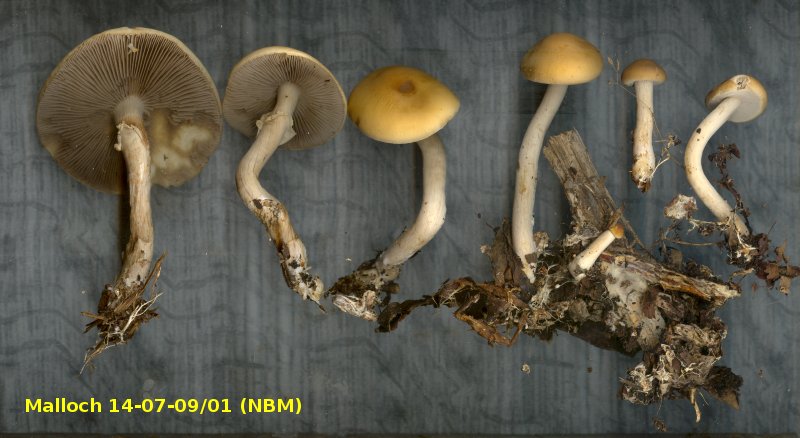
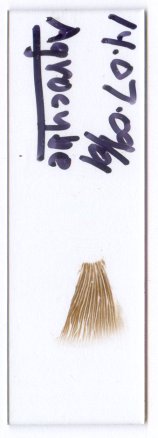
Agrocybe acericola is commonly found on wood chips or even logs of maple or other hardwoods. It is recognizable by its brown fruiting bodies, thin annulus that may remain as a ring on the stipe, and brown gills. The flesh is white, or nearly so, and has a strong mushroom or slightly solvent-like odour. Its taste (chew just a little and then spit it out) is decidedly farinaceous, resembling fresh flour or even cucumbers. The spore print, above right, is medium brown. The specimens in the photographs were found in mid-July growing on small pieces of woody debris under a large pile of mostly sugar maple firewood. The wood had been harvested during the previous winter and left in a pile following snow melt-off in April.
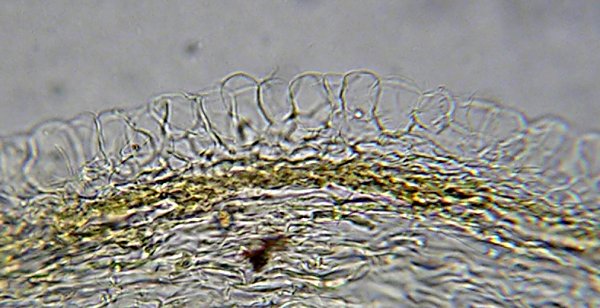
Recognizing A. acericola is not difficult. Its bright yellow-brown colour, brown gills, white annulus and brown spore print are diagnostic. There is some spossibility of confusing it with a species of Pholiota or Kuehneromyces, such as K. mutabilis. The best way to make a positive identification is to examine the specimen under a microscope. Species of Pholiota have spores that lack a germ pore, a structure easily seen at the top of each spore in our illustration below. Kuehneromyces species may be more difficult distingusih because their spores do have a germ pore. Here the distinction is best accomplished by making a thin section of the surface of the cap with a sharp razor. The photo at right shows such a section. The surface of the cap in A. acericola (and all other members of the genus Agrocybe) is composed of large swollen cells that form a dense palisade called a hymenoderm. This is quite unlike the cap surface of Kuehneromyces species, which is covered by a layer of hyphae similar to those of the lower tissues.
Aside from the surface of the cap, the two most notable microscopic features of A. acericola are its cystidia and basidiospores. As with many mushrooms there are two kinds of cystidia, cheilocystidia on the edges of the gills and pleurocystidia on the sides of the gills.
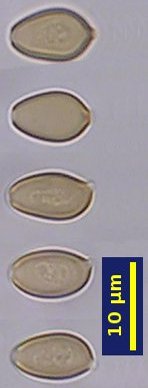
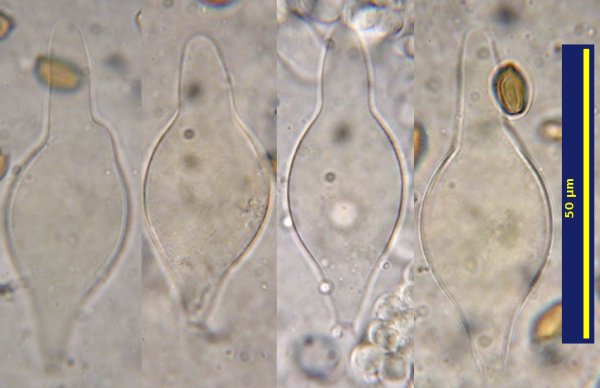
In some mushrooms the cheilocystidia form a continuous sterile tissue on the edges of the gills and differ in appearance from the pleurocystidia. In A. acericola the cheilocystidia are rather sparsely distributed along the edge of the gills and are similar to the pleurocystidia. The cystidia have a characteristic finger shape but are strongly swollen at the middle (near left). This shape, called utriform by most mycologists, is common among cystidia of many species of mushrooms, not just those of Agrocybe, but is one of just several different forms you might encounter.
The basidiospores of A.acericola, far left, are smooth, brown and, as discussed above, have a prominent germ pore at the top. Upon germination a hypha grows out through the germ pore and begins to establish a new individual. The basidiospores are not quite circular in cross section: the bottom three in the photo are shown in side view, while the top two are seen in dorsi-ventral view. These views can be distinguished easily by concentrating on the apiculus, the small "wart" at the base of the spore where it was attached to the basidium. The spores are seated asymmetrically on the basidium so that in side view the apiculus is off to one side while in dorsi-ventral view it is central. Understanding the true symmetry of basidiospores require that they be observed in such an alignment so that their three-dimensional shape can be appreciated.
Although most collectors are fairly confident they can recognize this species its exact identity and relationship to other species of Agrocybe is still not quite clear. Agrocybe acericola was first proposed as a new species in 1872 by the renowned American mycologist Charles Peck, who collected it on mossy trunks of maple trees in North Elba, New York. Originally published by Peck as Agaricus (Pholiota) acericola it was later listed as Pholiota acericola by Professor Pier Andrea Saccardo in Volume 5 of his monumental Sylloge Fungorum (1887). The species remained in Pholiota for another 73 years until Rolf Singer formally transferred it to Agrocybe. The question that is still asked is whether the fungus we call Agrocybe acericola today is the same species as that collected by Peck. We are also not yet certain that some mycologist before Peck's time had not already given it a name, which would then be the correct one by virtue of its seniority. There are several other named species, including A. alachuana, A. femnophylla, A. gibberosa, A. howeana, A paludosa, A. praecox var. britzelmayrii, A. praecox var. cutifracta, A. praecox var. praecox, A. praecox var. sylvestris, and A. sphaleromorpha.
In 1990 Flynn and Miller (Mycological Research 94:1103-1110.) addressed the confusion over the taxonomy of this group by obtaining Petri dish cultures of a great number of fungi in this group of species and studied their capacity to mate with one another. An isolate that mated successfully with another was considered to be of the same species and those that were sexually incompatible were considered to be of different species. These "biological species" were found by Flynn and Miller to be four in number and, disturbingly, essentially indistinguishable morphologically. The members of these species could distinguish one another but mycologists could not, at least on the basis of micro- or macroscopic appearance. However Flynn and Miller did find convincing ecological indicators of their species and were able to characterize the four species on that basis. These were:
Species I - Growing mostly in urban habitats where finely fragmented wood chips are used as a garden mulch. Found in North America and Europe
Species II - Growing on fragments of wood in western North America, usually in relatively undisturbed habitats
Species III - Growing on fragmented wood in litter or even on decaying logs. Restricted to northern hardwood forests of eastern North America
Species IV - Collected only once in a forested park in Denmark. It is still poorly known.
Flynn and Miller examined a number of "authentic" collections of their species, including Charles Peck's original dried material of Agrocybe acericola, the specimen on which the name is based. They considered Peck's material to be a member of the group under study, which would imply that it is probably to be found among the four biological species (unless, like the Denmark species, it is a representative of yet another species not represented in their set of cultures). If we accept the likelihood that A. acericola is one of the four biological species, which it probably is, then the most likely place for it is in Species III, by virtue of its geography and habitat. Again, we cannot be certain that the name Agrocybe acericola is the oldest and thus correct name for Species III, but for now it is our best guess
David Malloch
New Brunswick Museum